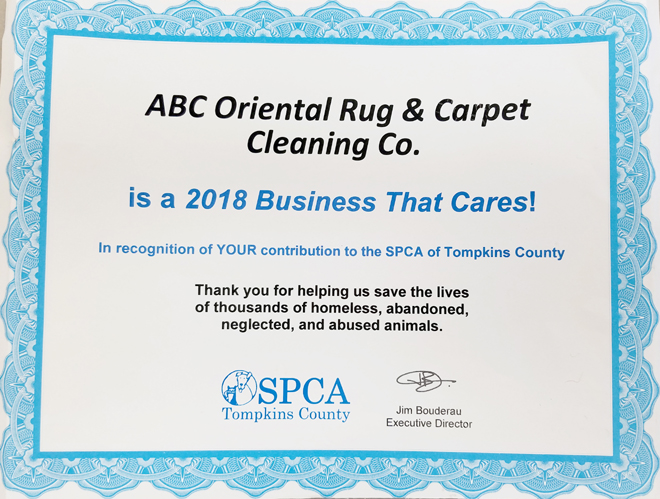ABC MONTHLY NEWSLETTER
JUNE 2020
Welcome to Our Monthly Newsletter!
We hope you will enjoy this month's articles.
This month's topics are:
COVID-19 PANDEMIC
AREA RUGS
MISCELLANEOUS
CONSIGNMENT RUGS FOR SALE REMINDER
If there is a topic you would like us to cover in one of our upcoming newsletters, please call us at
607-272-1566
or contact us by clicking here.
GREAT NEWS!
GOT QUESTIONS?
NOW YOU CAN TEXT US at
607-272-1566
HERD IMMUNITY & COVID-19
THE THEORY...
Herd immunity and COVID-19? You may have heard this theory in regard to the novel coronavirus pandemic. It goes something like this... If everyone gets infected, we'll eventually develop herd immunity against COVID-19 and everything will be OK.
Unfortunately, this postulation is only partly true. We might get herd immunity. But it certainly won't be OK!
Herd immunity happens when enough people in a population are immune to a specific disease and therefore protect everyone else who is not immune. The premise is based on the facts that viruses need us to survive. They copy themselves by using the machinery of our cells and have to jump from person to person in order to keep reproducing.
So, if you are somebody who is not immune to the virus, but you are surrounded by people who are immune (either through prior infection or a vaccine), then this herd of people are essentially serving as a shield around you, so the virus can't get to you.
DOES HERD IMMUNITY WORK?
Make no mistake. Herd immunity really does work. The problem is that you need a lot of people to be immune for it to take hold.
For example, polio needs upwards of 80 percent of the population to be immune for herd immunity to work. Pertussis and measles require more than 90 percent.
Practically speaking, you can never achieve 100 percent immunity because some people cannot get vaccinations either because they are too young or have compromised immune systems or have allergies.
But if you can keep the immunity rates above that critical threshold, then the herd keeps them protected. If you can maintain herd immunity for long enough, the virus will eventually disappear. Smallpox was eradicated that way. There is talk that polio may soon follow.
WHY DOESN'T IT ALWAYS WORK?
Given the number of people that have been infected by COVID-19, but with the limitations of testing, many people, especially early on in the pandemic, did not get tested. Also, many people tend to have no or very mild symptoms and may not have ever realized that they were sick.
So in reality, the number of people who have contracted COVID-19 is certainly much higher than the number of people who have tested positive and much higher than the numbers reported on the news.
So, even if we accept that the vast majority of cases of COVID-19 are undiagnosed, we are nowhere near achieving rates that would result in herd immunity.
COULD HERD IMMUNITY WORK FOR COVID-19?
The most important point is that herd immunity needs the majority of the population to be immune. What that threshold is for COVID-19 is not entirely clear, but it is a fair estimate that it is likely to require 60 to 70 percent of the population to be immune, based on what is known about other viruses.
ANOTHER PROBLEM WITH HERD IMMUNITY
For more information, please continue reading here.
TYPHOID MARY & COVID 19
The story of Typhoid Mary and the COVID-19 pandemic are very much related. The reason is that her case was the first incidence of forced isolation used to prevent the spread of an infectious disease by a person who is asymptomatic. As we are all too aware, forced isolation is playing a large part in helping to contain the spread of COVID-19 as well.
Today we worry about the SARS-CoV-2 virus (COVID-19), but viruses are not the only microbes that can spread disease. Bacteria are adept at that as well. Mary Mallon made the most delicious ice cream, but the problem was that it could kill. That is because Mary carried more than the ingredients needed for ice cream! She carried the Salmonella typhi bacterium, the bacterium that causes typhoid fever. And she was well-deserving of the name that was bestowed upon her, "Typhoid Mary."
TYPHOID FEVER TODAY
Today, typhoid fever is rare in North America thanks to sanitation and the use of antibiotics to prevent its spread, but it still strikes some 12 million people in the developing world every year.
Vaccinations are available and are a must for anyone traveling into areas where the disease is still found. Risk is reduced by drinking only bottled water, eating foods that have been thoroughly cooked and are still hot, and avoiding raw vegetables and fruits that cannot be peeled.
The typhoid bacteria, which live only in humans, can be spread through sewage or through food that has been handled by someone shedding bacteria. A high fever can ensue and even death if antibiotics are not available.
MARY MALLON'S STORY
Mary Mallon's story, as mentioned above, is about stopping the spread of a disease by an asymptomatic individual through the forced isolation of that person.
Before widespread water purification, epidemics of typhoid fever were common. But nobody really knew how the disease was transmitted. This was the case until 1906 when ten people in the same household in Long Island, New York, suddenly came down with typhoid fever.
Health authorities sent Dr. George Soper to investigate. Soper had experience with bacteria and knew that Salmonella typhi had been cultured from the stool of typhoid patients as early as 1884. He suspected that the disease could be passed from person to person and asked if there had been any visitors to the house. Yes, he was told, a new Irish cook had recently been hired but was no longer there.
Dr. Soper then traced Mary Mallon through an employment agency and discovered that there had been at least one case of typhoid everywhere she had worked. Finally, he caught up with her in a Park Avenue apartment where the owner's daughter had already died of typhoid and two servants suffered from it.
When he explained to her that she was spreading disease, Mary attacked him with a cleaver. The police were called and Mary was taken away screaming, kicking, and biting. Health officials found live bacteria in her stool, demonstrating for the first time that typhoid fever could be passed by people who carried the bacteria but were themselves immune to the disease.
Mary was forcibly isolated in Riverside Hospital for three years and was finally released when she agreed to never cook for others and check in every three months. She then disappeared, only to resurface five years later at another New York hospital where she had been hired as a cook! Twenty-five nurses in the hospital were ill with typhoid.
Mary was returned to Riverside Hospital where she was confined for the next twenty-three years, living in a cottage specially built for her. She finally died of a stroke. Her funeral was attended by only nine people because of the fear of catching typhoid fever from Typhoid Mary!
FORCED ISOLATION & COVID-19
For more information, please continue reading here.
VISCOSE RUGS
Viscose rugs (rayon rugs) are a manufactured product. The fiber is a cellulose fiber, regenerated from cotton and wood pulp by-products and made shiny with the use of a viscose liquid chemical processing.
The word, 'viscose' comes from 'viscous' or a material of a thick and sticky consistency.
Viscose or viscose rayon is an inferior fiber, manufactured to copy the attributes of silk without the prohibitive cost. It is also marketed as Banana Silk, Tencel, Ramie, Lycel, and Bamboo Silk. It is a fiber with a lot of by-products spun and processed together into staple fiber strands (short strands), and one never knows exactly what is in it.
Area rugs and other textiles made from viscose come with inherent problems as listed below:
INHERENT PROBLEMS OF VISCOSE RUGS
Shedding
Viscose rayon fibers are weak because the spinning of staple fibers into strands to weave means there is the possibility of a lot of breakage.
Regular foot traffic, as well as vacuuming, will pull out loose strands that often make the rug look like a cat has used it as a scratching post.
A professional rug cleaner will avoid scrubbing the rug during a cleaning process. Sometimes shaving or clipping of the worst areas may be necessary.
Bleeding and Fading
Viscose rayon rugs do not readily hold dye. They fade and bleed.
The professional rug cleaner will do a dye test to see if it is possible to safely clean the rug without ruining it. If the dyes are not colorfast, there are alternative cleaning methods available.
Yellowing
Cellulose fibers yellow when wet, so viscose has a good chance of yellowing when it is cleaned. Spills, especially, can often become yellow areas.
The professional rug cleaner has the ability to use an acid rinse to lessen the yellowing, as well as speed drying the rug or drying it face down.
Stiffening
Viscose rayon rugs can become stiff and matted after they are cleaned. This makes the fibers look blotchy and makes the top pile feel like cardboard to the touch.
Again, the professional rug cleaner will have solutions, combined with the laborious task of hand grooming the rug, section by section, to help loosen the stiffness.
Cutting Corners
Because the essence of the manufacture of this type of rug is trying to find a 'cheap' way to create the look of silk, there is a cost to cutting the corners of quality.
A viscose rug is one of the few rugs that look worse with time, and and even professional cleaning may be unable to return the rug to its original condition. Its best look will be on the day it was purchased.
Unfortunately, some unscrupulous dealers will sell these rugs at a high price, promising that they are made of real silk or have been highlighted with real silk, rather than viscose rayon fibers.
HOW ABC CAN HELP
Please continue reading here for more information on viscose rugs and the challenges they represent, complete with photos.
FLATTEN A FOLDED RUG
How to flatten a folded rug used to be a question asked much more often by customers. Years ago, area rugs were divided into 2 types, ones for the cold season and ones for the warm season. They were changed out each season and invariably, since some were folded rather than rolled, the folded rugs would often not flatten and lie flat on the floor as expected.
Even today, many people fold rugs as well, often due to space limitations. Though the question does come up, albeit not as often, it is a problem that must be straightened out (pun intended).
PREVENTION IS THE CURE FOR HOW TO FLATTEN A FOLDED RUG
- To prevent creases in a rug, the first step is to thoroughly vacuum and/or to clean it properly before storing.
- When possible, roll rather than fold it.Make sure to roll the rug into a tight cylinder with the pile facing in, since the pile is usually more fragile. Roll the rug as straight as possible. If this is hard to do, place a rod inside the rug and then roll.
- Wrap the rug after it is rolled in a protective fabric such as Tyvek or a cotton or muslin sheet.
- Store in a cool, dry environment, preferably off the ground, and do not put anything on top of the rug which could cause cracks and creases.
- As an extra precaution to make certain the rug stays cool and dry, use a fan or a dehumidifier.
BASIC SOLUTIONS FOR COMMON TYPES OF CREASES
Curled Corners
When corners won't lie flat, placing a heavy object on them can work. However, the best way is to fold the corners under and let them rest for a few days.
Rippling or Waves
These typically happen to a rug that is a new one. Just lay the rug flat and be patient. The creases will work themselves out.
Ironing
After 2 full days, if the first 2 solutions do not do the trick, ironing may be possible. So as not to damage the rug, check it to see if it is iron-friendly and take extra care.
Iron on the lowest setting possible with the steam on or if no steam setting, sprinkle some water first. Make sure to place a piece of brown craft paper between the iron and the rug to protect the rug from being burned by the iron.
MORE TIPS ON HOW TO FLATTEN A FOLDED RUG
For further information, please continue reading here.
FLAG DAY- JUNE 14
WHY JUNE 14?
Why is June 14 designated as National Flag Day? Not everyone would know how to answer this question.
Our veterans and current military are the most knowledgeable because they have fought to protect what it represents. Here is the history:
THE FLAG ACT
On June 14, 1777, the design of our first national flag was approved by Congress.
The Flag Act, stated: "Resolved, That the flag of the United States be made of thirteen stripes, alternate red and white: that the union be thirteen stars, white in a blue field, representing a new Constellation."
The 13 star flag is also known as the "Betsy Ross" flag. The Flag Resolution did not specify the arrangement of the stars nor the specific proportions of the flag. So many 13-star flags were used.
The 13 stars represent the 13 original colonies:
- Delaware (December 7, 1787),
- Pennsylvania (December 12, 1787),
- New Jersey (December 18, 1787),
- Georgia (January 2, 1788),
- Connecticut (January 9, 1788),
- Massachusetts (February 6, 1788),
- Maryland (April 28, 1788),
- South Carolina (May 23, 1788),
- New Hampshire (June 21, 1788),
- Virginia (June 25, 1788),
- New York (July 26, 1788),
- North Carolina (November 21, 1789),
- Rhode Island (May 29, 1790)
The flag has been modified 27 times since then. As new states joined the union, the number stars on the flag grew.
CURRENT FLAG DESIGN
The current design is courtesy of the late Robert Heft who, in 1958, was an 18-year-old high school student in Lancaster, Ohio. He designed the 50-star flag for a high school class project and received a B minus. Heft asked his teacher whether, if his design was accepted by Congress, his grade would be changed to an A.
In 1959, Heft got his A when President Eisenhower accepted his design of 50 stars to include Alaska and Hawaii. Heft's flag design was adopted by Congress in 1960.
NATIONAL FLAG DAY
Over 100 years ago, President Woodrow Wilson established June 14 as a day to fly our flag with pride. "I...suggest and request that throughout the nation and in every community, the 14th day of June be observed as Flag Day."
"There should be special patriotic exercises to express our thoughtful love of America, our comprehension of the great mission of liberty and justice to which we have devoted ourselves as a people, our pride and our enthusiasm for the political program of the nation, our determination to make it greater and purer with each generation, and our resolution to demonstrate to all the world its sentiment and purpose."
OFFICIAL FEDERAL HOLIDAY?
For more information on Flag Day as well as some flag trivia, please continue reading here.

BRING YOUR RUG TO
THE RIGHT PLACE
FOR
TOTAL URINE ODOR REMOVAL
No Fragrances
JUNE CLEANING SPECIALS
- 20% Off Rug Urine Odor Removal
- 2o% Off Rug Moth Repel
- 50% off In Home Carpet Sanitizer
***
Please call or text our office at
607-272-1566
for details!
THANK YOU!! WE LOOK FORWARD TO CONTINUING TO SERVE YOUR TEXTILE CLEANING AND REPAIR NEEDS!
Get New Posts Right To Your Inbox!
Get our monthly newsletter, just like this one, delivered right to your inbox each day. Just sign up and we will send you the best new articles and videos as they become available.
Your email address will NEVER be spammed, sold, or shared. You are welcome to unsubscribe at any time with the link in the email.
"The Cleanest Clean You've Ever Seen."
by
ABC Oriental Rug & Carpet Cleaning Co.
130 Cecil Malone Drive Ithaca, NY 14850
607-272-1566

ABC
Carpet & Rug
Spotting Guide

ABC Oriental Rug & Carpet Cleaning Co. has been family-owned and operated in Ithaca and surrounding areas for more than 49 years.
Our company is a reflection of our family name and pride.
Please Like us on Facebook!
for more information and to find out what we are doing at our business and in the community!
Stay Connected!
Links to Our Services
Allergy Cleaning
Area Rug Cleaning
Oriental Rug Cleaning
Rug Hand & Machine Repair
Upholstered Furniture Cleaning
Tile & Grout Cleaning & Sealing
We are proud sponsors of the SPCA of Tompkins CO:

Newsletter Archives


